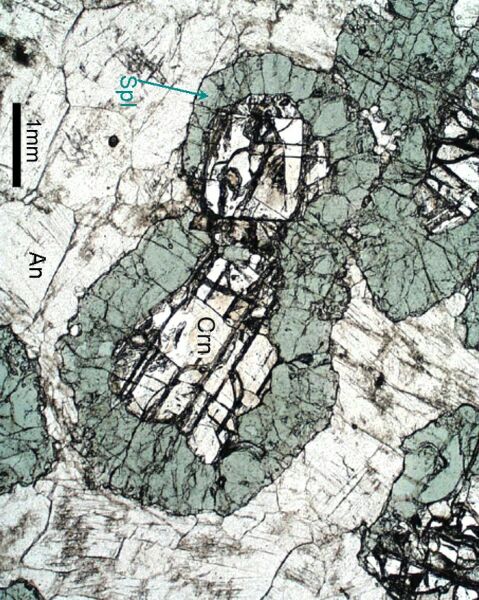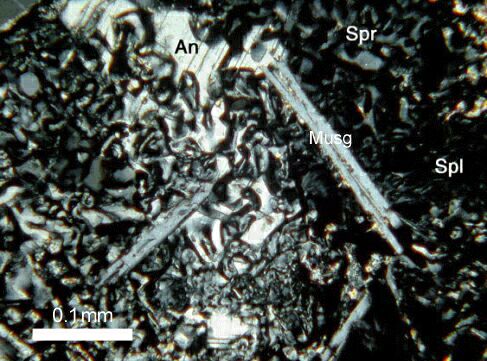

Musg : musgravite, An : anorthite, Crn : corundum, Spl : spinel, Spr : sapphirine.
18th GENERAL MEETING OF THE IMA (INTERNATIONAL MINERALOGICAL ASSOCIATION), September 2002, EDINBURGH, SCOTLAND.
Occurrence of musgravite in anorthite-corundum-spinel-sapphirine rocks ("sakenites") from South Madagascar: Evidence for a high-grade metasomatic event
B. Devouard 1, M. Raith 2, R. Rakotondrazafy 3, M. El-Ghozzi 4 and C. Nicollet 1
1 Laboratoire Magmas et Volcans, Université
Blaise Pascal-CNRS-OPGC, 5 rue Kessler, 63000 Clermont-Ferrand, France.
2Mineralogish-Petrologisches Institut, Universität
Bonn, Poppelsdorfer Schloß, 53115 Bonn, Germany
3 Département des Sciences de la Terre, Université
d'Antananarivo, Antananarivo, Madagascar
4 Laboratoire des Matériaux Inorganiques, Université
Blaise Pascal-CNRS, 24 Av. des Landais, 63177 Aubière, France
"Sakenites" are unusual high-grade metamorphic rocks composed of near end-member anorthite and Al-Mg-rich minerals (corundum, spinel and sapphirine), with or without phlogopite. They occur as deformed lenses within a series of biotite-sillimanite-cordierite-garnet gneisses of the Ihosy granulite unit in the north-west part of the Bongolava-Ranotsara shear zone of South Madagascar. Considering the geochemical data and their close association with amphibolites, pyroxenites, phlogopitites and marbles, the primary lithology of anorthite + corundum ± phlogopite in sakenites probably formed by high-grade (granulitic) metamorphism/metasomatism of clayey limestones. A second high-grade event lead to the partial to complete coronitic replacement of corundum porphyroblasts by spinel, spinel + sapphirine, or sapphirine + anorthite (photo).
Within some of the spinel and sapphirine reaction coronae around corundum, we identified musgravite as platelets up to 100 x 500 µm (photo). The crystals usually cut through the coronitic texture, but in rare cases musgravite seems to develop topotactically with spinel. Microprobe analyses, estimating Be by difference, lead to the structural formula Be0.95Mg1.91Fe0.13Al6O12, close to the ideal composition BeMg2Al6O12. However, since the distinction from taffeite, BeMg3Al8O16, is very difficult on the basis of optical and microprobe data, we extracted a 50 x 30 x 100 µm crystal fragment from a thin section using a Medenbach microdrill. Unit cell dimensions, determined using a four-circle CAD4 diffractometer by centering on 25 reflections, are compatible with a = 5.68 Å, c = 41.36 Å cell parameters in the R-3 space group, unambiguously confirming the identification of musgravite.
The textural features suggest that the coronitic replacement of corundum to spinel ± sapphirine was caused by infiltration metasomatism. The occurrence of a Be-rich phase in the assemblage comforts this origin. As noted by several authors, Be is a relatively immobile, low-concentration element in high-grade metamorphic rocks. Its transport requires a fluid phase, and aqueous, F-rich fluids, are usually invoked. This metasomatic fluid would also be the carrier of Mg and Si necessary for the corundum -> spinel + sapphirine reaction. We propose that this metasomatic event could be, at least in part, related to the emplacement of Be and B-rich pegmatitic bodies frequently observed in the Sakena region, and considered to be associated with the development of the Ranotsara ductile shear zone, under c. 700°C and 4-5 kbar.


Musg : musgravite, An : anorthite, Crn : corundum,
Spl : spinel, Spr : sapphirine.